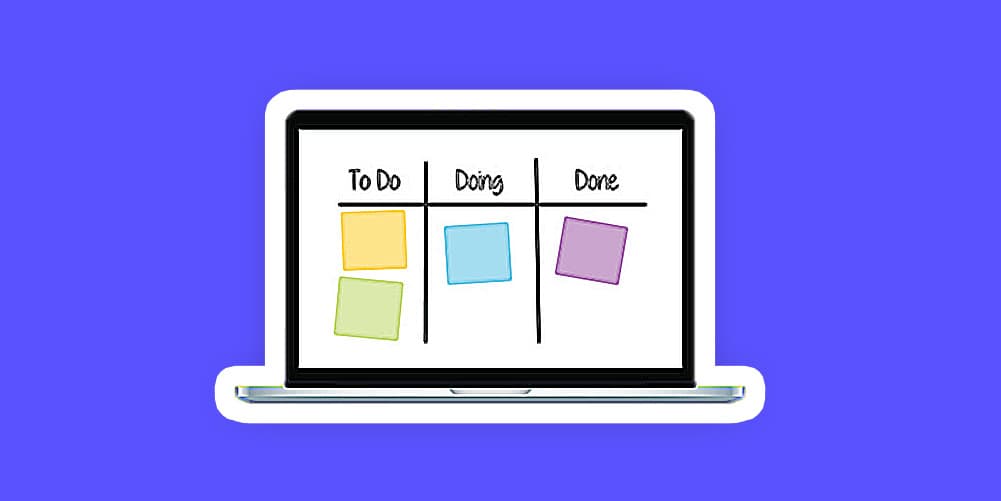
Project Management Methods: Agile vs Scrum vs Kanban vs Waterfall
What are the differences between Agile, Scrum, Kanban, and Waterfall?
In this blog post, I want to explore these project management methods, outline their pros and cons, and help you decide on a methodology that works for your agency.
Choosing the correct method is paramount to your success as a team.
What you're working on is probably very clear to you by now. However, figuring that out is only the tip of the iceberg.
A good management structure defines how you and the people at your company will work on your project.
Consistently following the same processes, having a clear overview of what needs to be done, and being held accountable for your assignments helps to ensure work gets done—and in a timely manner, too.
How to choose a project management method
There is no perfect, "one-size-fits-all" way to manage a project.
There are a lot of options out there, and to find one that will allow you to meet your success criteria, there are several factors to consider:
- Rigidity vs. flexibility: is your project subject to a lot of changes and iterations along the way? Do you expect a dynamic environment, or do you rather have a specific budget, tools, and sure-footed roadmap you must follow?
- Collaboration: do you need input from others to complete your own tasks? Does your project involve a lot of collaboration and is your team equipped for efficient communication?
- Experience: do you already have experience with project management? If so, more rigid, collaboration-based methods will probably work well for you. If not, opt for flexibility or "solo work" methodologies!
- Resources: how big is your team, how much time can you spend on extensive documentation, and finally—how much money can you afford to invest in project management tools? All of these factors must be considered when choosing a methodology.
The key takeaway from this is that you must ensure you know what you're supposed to do from the beginning until the end.
One easy way to do this is to evaluate what you know about the end result. If you know exactly where you're headed, go for a structured methodology like Waterfall. If you're not quite sure, or open to some flexibility—try Agile instead.
Finally, you should also consider your teamwork efficiency. Is your team likely to collaborate—are you in an office or at home, do most people work part-time, or are they available 24/7? Do they have access to the proper collaboration tools?
Agile
Agile practices involve "discovering requirements and developing solutions through the collaborative effort of self-organizing and cross-functional teams and their customer(s)/end-user(s)" (Wikipedia).
So what does this mean exactly?
The Agile methodology first emerged as a form of management for software development projects.
Graphically, it can be represented like so:
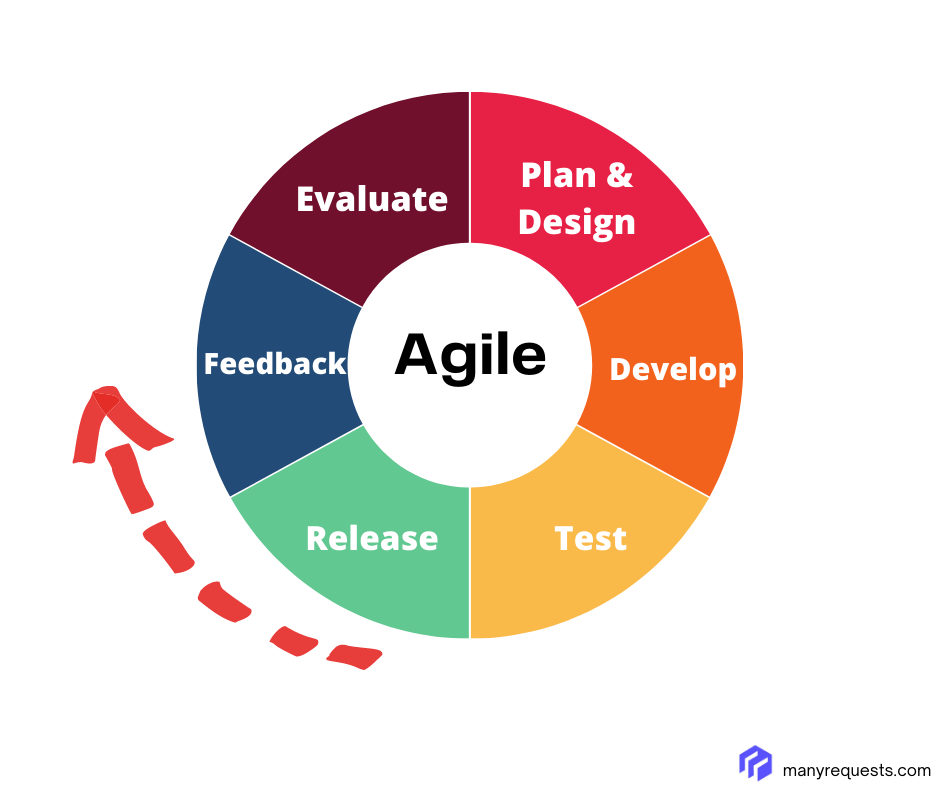
Agile is a fast and flexible approach that works in just a couple of steps: develop something, release it to your ideal customer, receive feedback, and get right back to designing.
It's no surprise that this works so well for software—however, this methodology can be applied to any other type of project, too.
Agile Pros & Cons
Pros:
- Extremely flexible. If you're not sure what the final version of your software/service/product will look like, go Agile.
- Get your product to market faster. From the get-go, you can generate revenue, and have your clients or customers shape your final product.
- Better communication. With this method, you're likely to be in touch with your customers from start to finish.
Cons:
- Difficult to predict. You may have to pivot multiple times, and possibly go for something completely different than what you first wanted to create.
- Hard to do in practice. Agile projects require real commitment, and your first attempts are not likely to go well.
- Very intensive. Constantly updating your services or software to respond better to the market might be costly, in terms of both resources and time.
- Difficult to implement for larger teams.
Scrum
Scrum is very similar to Agile in terms of principles: flexibility and short-term iterations.
You could represent Scrum like this:
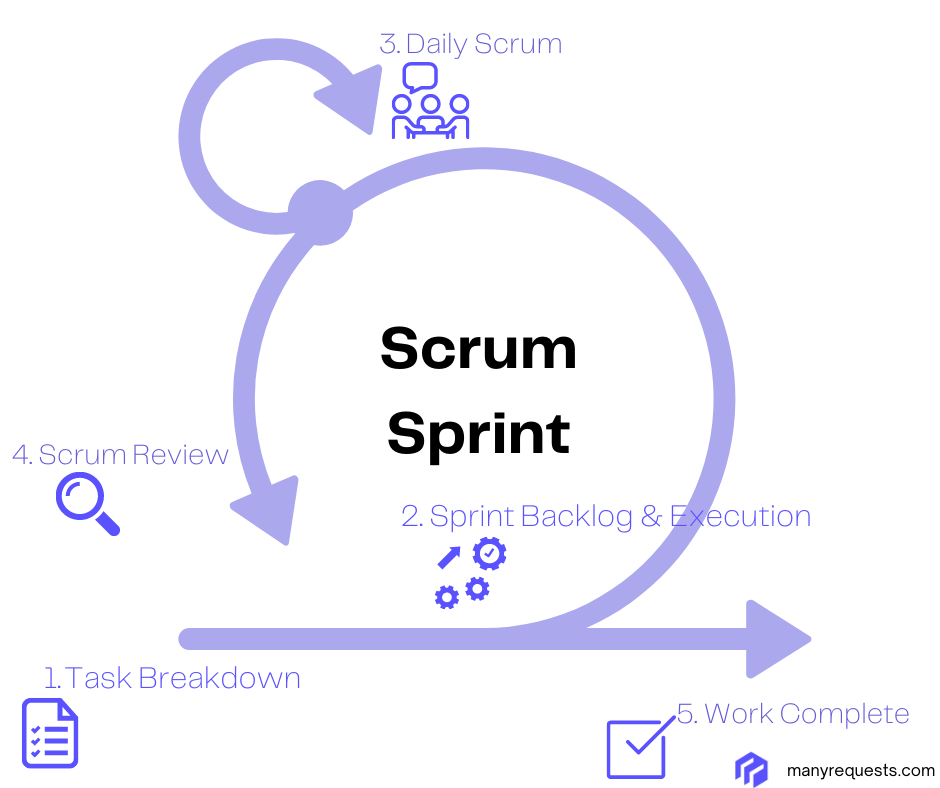
The Scrum method places the team at the center, and expects it to self-manage and self-organize with "sprints".
Sprints are 30-day work sessions with daily stand-up meetings. For example, the project is divided into X amount of sprints, which are themselves divided into X amounts of (small) tasks.
Tasks are then completed on the daily, and team members are expected to stand-up regularly ("today I did X, which allows us to do Y and Z tomorrow").
It's a fast-paced methodology, which might not work for everyone. It also requires extreme discipline to do meaningful tasks every day and stand up for them.
Scrum Pros & Cons
Pros:
- Expect to ship quickly and efficiently. Scrum is all about speed.
- Effective use of your resources.
- Constant meetings and stand-ups help make every individual accountable. Efforts are recognized.
Cons:
- High chance of failure in case of low commitment or cooperation from team members.
- Difficult to implement in larger teams.
- Daily meetings or expecting to stand up may frustrate some members.
Kanban
Kanban encourages small, incremental, and efficient steps towards project completion.
It is fairly straightforward in principle: a visualized, real-time workflow (called the Kanban board) that helps determine and track the amount of work that must be completed for each phase.
You could represent Kanban like this:
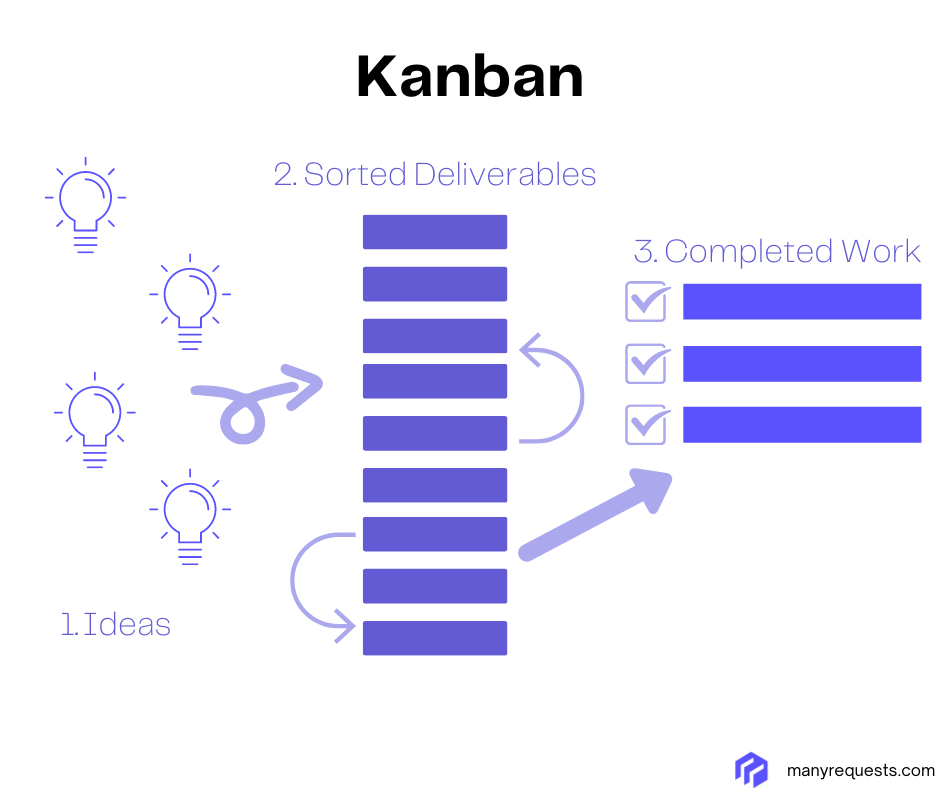
The goal here is to reduce "work in progress" issues.
Determine the amount of work that must go into each phase, and break it down into simple, trackable tasks that will help increase throughput as well as speed.
Kanban Pros & Cons
Pros:
- Visibility. Kanban helps your team get on the same page and clearly visualize what's next.
- Flexibility. It's easy to reorganize, prioritize, and sort your deliverables again and again depending on your client or market's needs.
- Easily expose issues with your project. For example, if a column becomes too long, it may indicate a problem with your resources.
Cons:
- Kanban's flexibility also creates issues with accountability and responsibilities.
- Complexity. A massive board can create confusion among your team, and make it difficult to figure out what the next step is.
- Lack of timing. Most Kanban boards do not include strict deadlines, or are not updated often enough by team members.
Waterfall
The Waterfall is a linear, easy-to-understand, critical-path-focused project management methodology.
This method is pretty straightforward and is a process in which the phases of the project flow downward.
In other words: once you complete a phase or task, you move on to the other. Simple as that!
It can be represented like this:
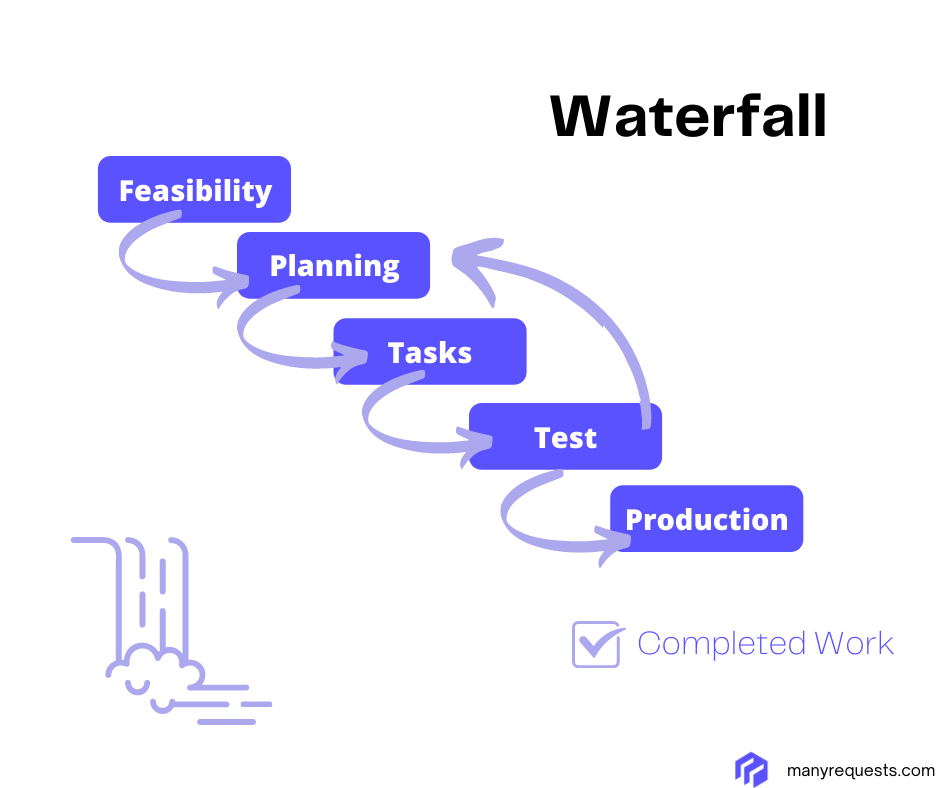
The model is best used in rigorous projects, where everything is determined, planned, and scheduled well in advance.
Waterfall Pros & Cons
Pros:
- Step-by-step structure. With Waterfall, it's easy for the entire team to always know what comes next.
- Clear end goal. Commit to a specific deliverable from the very beginning.
- Highly methodical, with a comprehensible transfer of information from one phase to the next one.
Cons:
- Little flexibility. If a phase or task is over, it's hard to backtrack and modify the completed work without impacting the next phase.
- Delayed feedback. Because Waterfall usually focuses on reaching the end goal, there is no shaping of the product/service while it is already in production.
- Not desirable in projects where requirements constantly change.
Wrapping Up...
We hoped you enjoy this comparison of different project management methods, and that this post helps you find a methodology that works for you.
Which method are you thinking of implementing for your next project?
Let us know in the comments section!
Running an agency?
ManyRequests is an all-in-one client portal and client requests management software.
Learn more